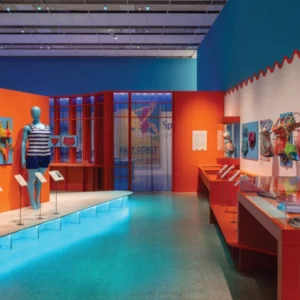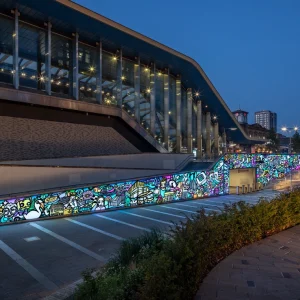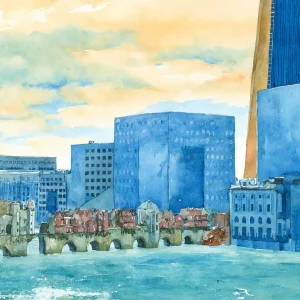We’ve had a long relationship with the city and you can see now that it’s really flourishing,’ says Nick Birchall, principal with architecture practice Swanke Hayden Connell and who heads up the firm’s Istanbul projects. Yes, one of Turkey’s most historic cities is shaping up to be one of the most future facing, judging by the amount of activity in the sectors of architecture and design
One need only look at its population growth to see the driver for this boom in the built environment: It has gone from 2.7 million in 1980 to more than 13 million in 2011. Istanbul’s 12 tallest skyscrapers have all been completed since the turn of the millennium and there is still demand for new apartments all around the city.
Swanke Hayden Connell’s Tekfen Tower, completed in 2002, is one of the pioneering Grade A office developments. The practice is leading the charge in this decade too, with a raft of projects already under its belt and more in the pipeline.
A fit-out for Microsoft was completed in 2010, a mix of streamlined white curves, pops of primary colours and textural interest. This was followed by ones for KPMG at the end of last year, where creating flexibility within the workspace was key. A 700 sq m office for Google was recently completed.
The Tekfen Oz Levent Ofis, an office development of some 16 000 sq m, was completed in 2011 and received a LEED Gold rating. Much like office space in any metropolitan centre these days, the environmental friendliness of the fit-out is coming to the fore. ‘It’s only in the past three or four years that developers have begun to take the sustainability question more seriously,’ says Birchall. This office is located on the Asian side of Istanbul, a zone within the district of Atasehir, which has been given special status by the Turkish government to promote the development of the city as a new financial hub. ‘There’s quite a major change of dynamic in the city in terms of the activity on the Asian side,’ he continues, "The city has recognised that it needs different sources of employment.’ Atasehir is easily accessible by road from Levent to the west and Sabiha Gökcen International Airport to the east.
The NIDA Palladium Tower, also located on the Asian side, has just begun construction. This 40-storey tower will be another addition to the burgeoning Istanbul skyline, with Swanke Hayden Connell responsible for the public areas. The practice is due to complete the Cengiz Group headquarters this year. ‘What tends to happen in Istanbul is a really integrated mixed use of office and residential,’ says Birchall. ‘It’s not just the skyline of the city, it’s how the infrastructure keeps up that’s important."
This emphasis on mixed use can clearly be seen in a project by architecture practice RMJM, another firm making inroads into design in this city. RMJM’s Dubai studio has just received planning approval for the scheme, which includes one of the tallest towers in Europe. The project consists of three towers. The main one will comprise offices, serviced apartments, a hotel and a 30 000 sq m public shopping mall. There will be a separate residential-only tower with the final one will be dedicated to office space, again in the new financial district.
Turkish construction companies Varyap and GAP Insaat are developing the project, with construction beginning soon and due to complete by 2015. ‘The tower reflects all that is truly inspiring about modern-day Istanbul and symbolises the dynamism and confidence of Turkey in 2012. Our intention was to create a new public destination, a new heart for Atasehir, that was inclusive and accessible for the people of the city,’ says Jonathan Knight, RMJM design principal.
‘The brief was for a design destination,’ adds RMJM managing principal Chris Jones. ‘The wider project provides many different spaces that reflect the diversity of the city’s fabric. The streets, gardens, squares, gateways, stairways and boulevards all contribute. Istanbul has so many influences, from Byzantine, Ottoman and Greek through to art nouveau and more modern typologies.’
Nick Birchall agrees: ‘It’s a very cosmopolitan city. It’s actually more of a Mediterranean city than a Turkish city.’ He cites a number of Istanbul-based firms: ceramics manufacturer VitrA and furniture firms Koleksiyon Mobilya, Nurus Mobilya and Tuna Mobilya as examples of suppliers that are really pushing the design boundaries. ‘Istanbul is a city that unites so many different aspects, as design does. It has so many sources to be inspired by,’ adds Aziz Saruyer a designer with Istanbul-based furniture company Derin, a regular fixture at major international trade fairs.
It’s this mix of old informing new design that is also evident at the ESPA at the luxury Istanbul Edition hotel. ‘The spa reflects the spirit of the city, steeped in rich traditions and ancient rituals. The architecture of the hammam – a dome with star-shaped cut-outs which filter the natural light – became the thread that weaves together the spas’s design details,’ says Inge Moore, principal at interiors practice HBA London.
The interior walls run at interesting angles to create intimate nooks and the theme is continued through the use of dramatic mood lighting "We were able to make it fresh by playing with scale, texture and materials. Instead of white and white stone, we opted for a rich, dark-brown tones."
HBA commissioned local artisans including a glassblower, woodworker and metalworker to contribute to the project. She adds: ‘Traditional skills are highly valued and artisans are given the opportunity to be entrepreneurial in a way that is not possible in other parts of Europe. There are also a lot of contemporary galleries that have a youthful and energetic spirit. Going out is important and designers like to see and be seen at the latest venues.’
Deniz Bozkurt of Istanbul-based furniture and lighting firm Autoban concurs: ‘With the young generation emerging there has been a rapid increase in successful Turkish design and investment generally. Istanbul is a very attractive city to designers.’ Autoban is just one of many firms figuring on the international design stage. It is currently working on an aparthotel in Zurich and a concept house that will appear in the designjunction event later this month.
Back in Istanbul, it is collaborating with the Nef Dört Leven project, scheduled to complete in 2014. This combines duplex apartments with facilities such as a basketball court and cinema. The project architect is an up-and-coming local practice Mimark, which is working with big name HOK.
In terms of design education, Istanbul benefits from two sources: those who have chosen to study at one of the city’s technical universities and who continue to have a long-standing relationship with their tutors long after they graduate, and those who are educated abroad who bring a different design perspective into the mix. ‘There’s a lot of good buildings created by local design professionals. The Turkish staff I work with are well trained and incredibly creative,’ says Birchall. He also cites the influence of the design organisation Arkitera, which promotes the city’s local makers to keep up the momentum of Istanbul’s emergence as a design city.
It is against this background of vibrancy and a flourishing design scene that the inaugural Istanbul Design Biennial is to take place. From October to December this year, it will be a showcase for a range of design disciplines from architecture to graphics, interiors to fashion. Says co-curator Emre Arolat: ‘One of the primary objectives is to celebrate this creative potential and share it with an international audience. We believe the design discourse of Istanbul will enrich the global design culture.’
Already its citizens are not averse to a bit of out-there art and design as exemplified by Ovo, an egg-shaped interactive artwork recently unveiled at the Marmara Forum, a downtown shopping centre. Composed of accoya wood, it is a collaboration between Belgian CAD exponent Odeaubois and lighting specialist ACT Design. Visitors are treated to a multisensory experience courtesy of lighting animations, visuals and acoustic accompaniment. And because it is made of a cross spiral of sustainable timber and LED lighting, it doesn’t just work on an aesthetic level but on a sustainable one too.
Certainly those who have worked and spent time in the city are wholly bought in to Istanbul’s coming of age. The ESPA was designer Inge Moore’s first project in the city. She is now working on a spa and restaurant at the Raffles Istanbul Zorlu Center, another mixed-used project encompassing a performance arts centre, offices, residential, retail and hotel, which will complete next year. She says: ‘The significance of the city having one foot in Asia and the other in Europe is a really hot topic and it’s working hard to definite its present-day role.’





